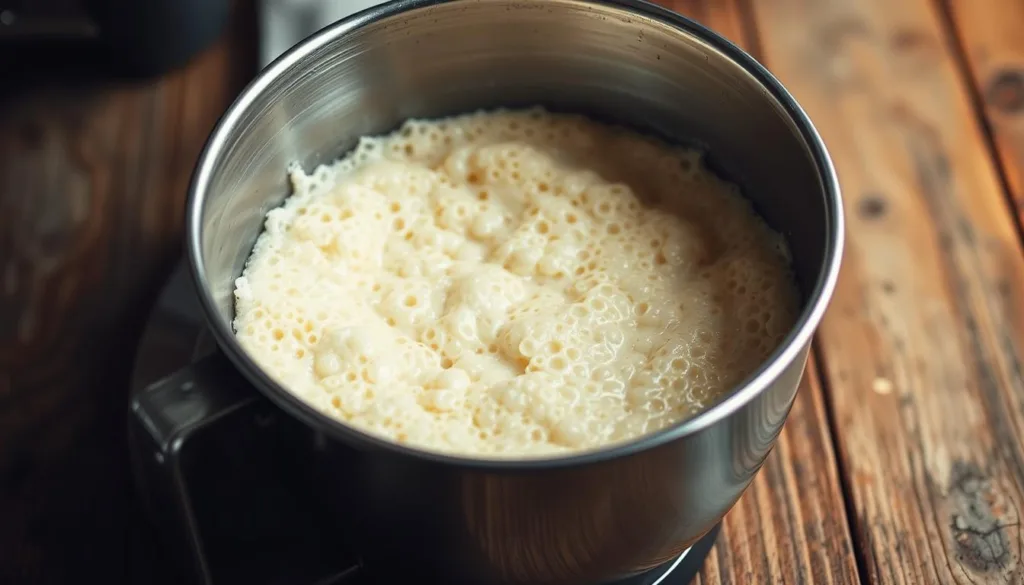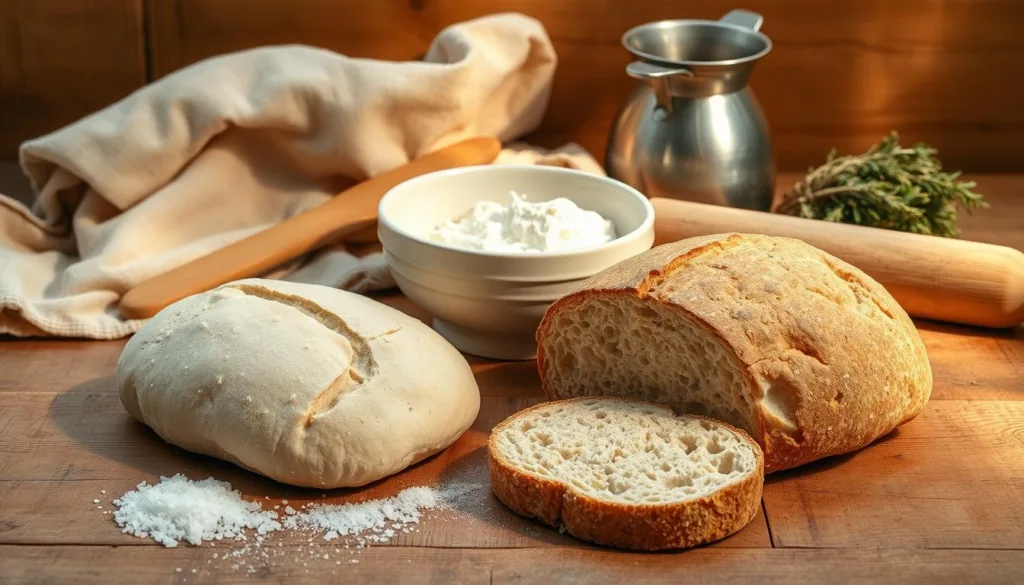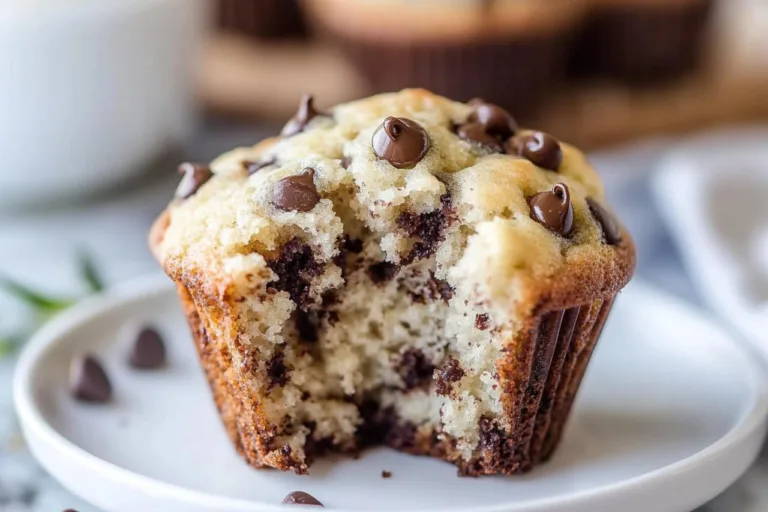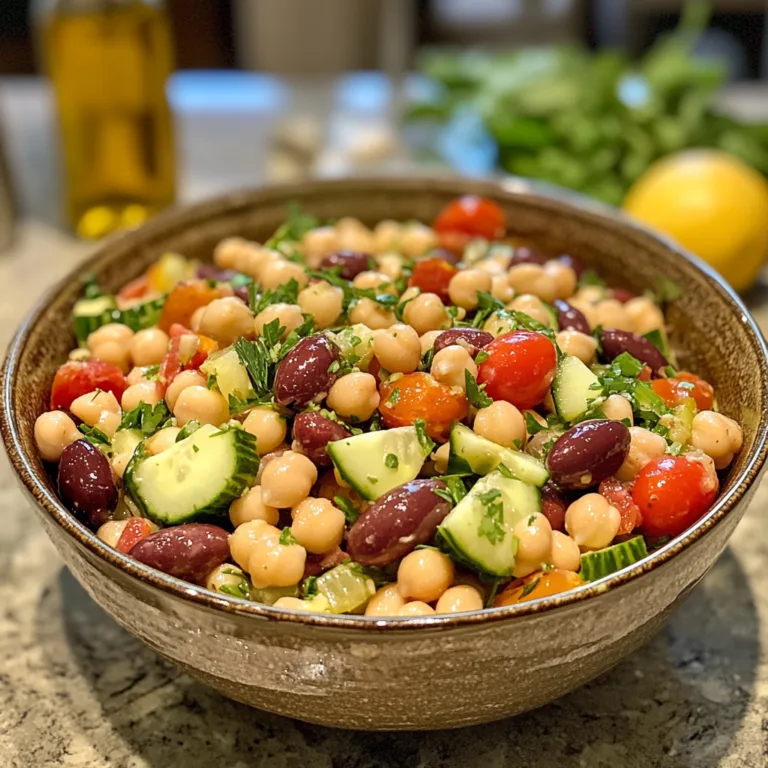Explore the world of sourdough bread baking with our simple recipe. It turns four basic ingredients into a tasty, artisan-style loaf. Sourdough is more than bread; it’s a journey into traditional baking that brings amazing flavors.
Starting your sourdough adventure means learning the basics. Homemade sourdough has a unique taste and texture from natural fermentation. With a few ingredients and patience, you can make a beautiful loaf at home.
This recipe is great for both newbies and seasoned bakers. The steps might look complex, but we’ll make them easy to follow.

Key Takeaways
- Requires only 4 basic ingredients for authentic sourdough
- No special kneading techniques needed
- Suitable for busy home bakers
- Creates a delicious bread with closed crumb texture
- Can be stored for 4-5 days at room temperature
Understanding the Art of Sourdough Baking
Sourdough bread recipe is a fascinating tradition that turns simple ingredients into a special treat. It’s different from commercial bread because it uses natural fermentation and complex flavors. This makes sourdough bread recipes with starter stand out.

The magic of sourdough comes from its unique qualities. It’s not like regular store-bought bread. Wild yeasts and bacteria work together to create a remarkable transformation during fermentation.
What Makes Sourdough Unique
Sourdough bread recipes are different from regular bread in several ways:
- Natural fermentation process
- More complex flavor profile
- Enhanced nutritional value
- Improved digestibility
The Science of Natural Fermentation
During fermentation, bacteria make organic acids like lactic and acetic acid. These acids give the bread its tangy taste and amazing texture. Wild yeasts generate carbon dioxide and ethanol, which help create the bread’s airy structure.
“Sourdough is more than bread—it’s a living process of transformation.” – Artisan Baker
Benefits of Homemade Sourdough
Making sourdough bread at home has many benefits:
- Complete control over ingredients
- Healthier digestive properties
- Enhanced nutritional absorption
- Deeper connection to traditional baking methods
By understanding these processes, you’ll see sourdough as an art form. It’s more than just making bread.
Essential Tools and Ingredients for Success
Making a tasty basic sourdough bread recipe needs more than just flour and water. Your sourdough bread starter recipe requires specific tools and ingredients. These are key to success in your baking journey.

To make the perfect sourdough loaf, you’ll need some essential equipment:
- Large mixing bowl for combining ingredients
- Kitchen scale for precise measurements
- Combo cooker or Dutch oven for even baking
- Proofing baskets (bannetons) for shaping
- Bench knife for dough manipulation
- Instant-read thermometer for temperature control
- Scoring blade for creating beautiful bread patterns
- Parchment paper for easy transfer
Choosing high-quality ingredients is vital for your sourdough bread starter recipe. Use flours like Bob’s Red Mill Artisan Bread Flour for its excellent protein content. Precision matters – use a digital scale for accurate measurements.
Your key ingredients should include:
- Bread flour (80%)
- Whole wheat flour (15%)
- Rye flour (5%)
- Fine sea salt
- Filtered water
- Active sourdough starter
Temperature and timing are crucial for sourdough success. Aim for a dough temperature of 78°F (25°C). Keep the ambient temperature between 74-76°F during bulk fermentation.
Creating and Maintaining Your Sourdough Starter
Starting a sourdough bread starter is a fun journey into natural fermentation. Your homemade starter is the key to making delicious sourdough bread recipe. It turns simple ingredients into a living, breathing culinary magic.
Creating your sourdough starter needs patience and regular care. You capture wild yeasts and bacteria in flour and air. This creates a unique mix of flavors and textures.
Building a Healthy Starter from Scratch
To make your quick sourdough bread starter, you’ll need:
- Medium protein white flour
- Whole grain rye flour
- Room temperature water
- Clean glass jar
- Silicone spatula
Feeding Schedule and Maintenance Tips
To keep your starter healthy, follow a regular feeding schedule. The best routine is:
- Feed it twice a day
- Every 12 hours
- Use a 1:5:5 ratio (20% ripe starter, 100% water, 100% flour)
Try to keep the temperature around 80°F (26°C) for best fermentation.
Signs of a Mature and Active Starter
A mature sourdough starter has clear signs:
- It bubbles consistently
- It rises and falls in a pattern
- It has a strong, slightly sour smell
- It’s loose and active
Your starter is ready when it doubles in size in 4-8 hours after feeding. It should also have a regular fermentation pattern.
Sourdough Bread Recipe
Making the best sourdough bread recipe needs patience, precision, and passion. This recipe will turn your kitchen into a real artisan bakery. It will give you a delicious loaf with amazing flavor and texture.
- 50 grams active sourdough starter
- 305 grams filtered water (85-90°F)
- 370 grams bread flour
- 30 grams whole wheat flour
- 7 grams fine sea salt
Your baking timeline will look like this:
| Stage | Duration |
|---|---|
| Bulk Fermentation | 6 hours |
| Stretch and Fold | 2 hours (4 sets) |
| Final Rise | 2 hours |
| Baking | 45 minutes |
Here are the key baking instructions for your sourdough bread recipe:
- Mix ingredients until fully incorporated
- Perform 4 stretch and fold sets
- Allow dough to rise at 72°F
- Preshape and rest for 15 minutes
- Shape and place in banneton
- Proof for 2 hours
- Bake at 450°F for 20 minutes
- Reduce to 430°F for 25 minutes
Pro tip: Let your bread cool for at least 1 hour before slicing to achieve the perfect texture.
Try adding 3/4 cup of fruit blend or 1/2 cup of toasted nuts for exciting flavor variations!
The Importance of Temperature and Timing
Mastering temperature and timing is key for making great sourdough bread recipe. The right temperature affects the bread’s taste, texture, and quality.
Knowing the science behind temperature is important. The best room temperature for sourdough is between 68°F to 76°F (20 to 24°C). This range helps your dough develop great flavors and rise well.
Ideal Room Temperature for Fermentation
Different stages of sourdough bread making need specific temperatures:
- Bulk fermentation: 75°F to 78°F (24 to 25°C)
- Proofing: 75°F to 85°F (24°C to 29°C)
- Starter activation: 80°F to 90°F (27°C to 32°C)
Managing Seasonal Temperature Changes
Seasonal changes can affect your sourdough bread recipe. In colder months, you might need to:
- Use a warm spot in your kitchen
- Create a DIY proofing environment
- Adjust fermentation times
Time Management Tips for Perfect Results
For your sourdough bread recipe, consider these time tips:
- Use an instant-read thermometer to monitor dough temperature
- Adjust fermentation time based on room temperature
- Plan for longer fermentation in cooler environments
Consistent temperature means predictable fermentation and tasty homemade sourdough bread recipe.
Mastering the Stretch and Fold Technique
The stretch and fold technique is a game-changer for anyone making sourdough bread recipe. It helps develop gluten and adds air to the dough. This makes your bread light and airy.
Here’s how to perform the perfect stretch and fold:
- Wet your hands with water to prevent sticking
- Use two hands to lift one side of the dough
- Stretch the dough upward gently
- Fold the stretched portion completely over to the opposite side
During your sourdough bread making process, you’ll want to complete four strategic folds: one at each compass point (North, South, East, and West). You’ll do 2-3 sets of stretch and folds, with each set about 30 minutes apart.
Key tips for successful stretching and folding:
- Maintain a consistent room temperature around 72°F
- Let the dough rest 30 minutes between fold sets
- Be gentle to avoid deflating the dough
- Watch for increased elasticity with each fold
This technique is great for both traditional and sourdough rye bread recipes. It builds strength and structure in your dough. This ensures a beautiful, well-risen loaf with an impressive crumb.
Shaping and Scoring Your Sourdough Loaf
Learning to shape and score your sourdough is key to making a beautiful, tasty loaf. These steps can turn a simple loaf into a work of art.
Basic Shaping Methods
Shaping your sourdough is vital for its look and feel. Here’s how to do it right:
- Lightly flour your work surface
- Use a bench knife for precise movements
- Create tension by gently pulling the dough towards you
- Aim for a smooth, tight outer skin
Creative Scoring Patterns
Scoring your sourdough makes it stand out. The right method can add beauty and let the bread expand properly.
| Scoring Pattern | Difficulty Level | Visual Effect |
|---|---|---|
| Simple Cross | Beginner | Classic, clean look |
| Wheat Stalk | Intermediate | Intricate, artistic design |
| Geometric Shapes | Advanced | Unique, modern appearance |
Common Shaping Mistakes to Avoid
Even pros can struggle with sourdough shaping. Here are common mistakes to steer clear of:
- Over-handling the dough can reduce its rise and texture
- Insufficient surface tension leads to flat loaves
- Using dull scoring tools that drag instead of cut cleanly
- Inconsistent dough hydration affecting shaping
Pro tip: Chill your dough for about 30 minutes before scoring. This helps prevent deflation and gets you crisp, clean cuts.
Baking Methods and Equipment
Learning to bake sourdough bread is all about the right tools and techniques. The baking method you choose can greatly affect your bread’s texture and taste. This is true for sourdough bread recipes that use a starter.
The Dutch oven is a top choice for home bakers. It creates a perfect environment for sourdough, trapping steam for a crispy crust. Here’s how to use a Dutch oven:
- Preheat the Dutch oven to 500°F
- Transfer your scored dough onto parchment paper
- Bake covered for 25-30 minutes
- Remove the lid and continue baking for 10-15 minutes
Other baking methods can also work well. A baking stone with a steam tray can give you a similar crust. Professional bakers suggest starting at 450°F, then lowering to 400°F for the rest of the bake.
Keeping your oven at the right temperature is key. Your oven might be different, so you’ll need to try and see. Look for that golden crust and listen for the crackling sound that means it’s done.
Pro tip: Invest in an accurate oven thermometer to ensure precise temperature control during your sourdough bread baking journey.
Troubleshooting Common Sourdough Issues
Mastering a basic sourdough bread recipe can be tough. But knowing common problems makes you more confident. Every sourdough journey has surprises, so don’t worry if things don’t go as planned. Baking sourdough bread starter recipe needs patience and practice.
Sourdough baking has its own set of challenges. Even experienced bakers can get frustrated. The trick is to spot problems early and fix them fast.
Dealing with Sticky Dough
Sticky dough can make baking sourdough seem impossible. Here’s what pros suggest:
- Wet your hands instead of adding extra flour
- Use a bench scraper for handling
- Let the dough rest for 15-30 minutes to strengthen gluten
Fixing Dense or Flat Loaves
Getting the perfect rise is all about fermentation. Dense loaves often come from:
- Weak starter
- Not enough bulk fermentation
- Bad shaping techniques
Addressing Fermentation Problems
Your sourdough starter’s health is key to good bread. Temperature, feeding schedule, and starter maturity are vital. Keep the environment at 74-76°F for best results.
Remember, every sourdough journey is unique. What works for one baker might need adjustment for another.
Storage and Serving Suggestions
After making your quick sourdough bread recipe, it’s important to store it right. Let it cool completely on a rack for at least two hours before slicing. This step helps the bread keep its texture and taste.
Storing your sourdough bread recipe needs some thought. For a crusty loaf, keep it uncovered for up to 12 hours. Then, store it in an airtight bag at room temperature for 4-5 days. Freezing is great for longer storage – just slice and separate with parchment paper.
To thaw frozen bread, reheat it in a 350°F oven for 15 minutes after spraying with water. Always slice from the center to keep the rest fresh. When your sourdough gets old, turn it into croutons, breadcrumbs, or bread pudding. This way, you enjoy every bit of it.
FAQ
What is sourdough bread recipe and how is it different from regular bread?
Sourdough bread uses a natural starter instead of commercial yeast. It tastes tangy and is more nutritious than regular bread. The fermentation process gives it a unique flavor and chewy texture.
How long does it take to make sourdough bread recipe?
Making sourdough bread takes 24-36 hours. This includes starter prep, fermentation, and baking. Most of this time is spent waiting for the dough to rest and ferment.
Do I need special equipment to make sourdough bread recipe?
You don’t need special equipment, but some tools can help. A Dutch oven, kitchen scale, and proofing basket are useful. Basic kitchen items like bowls and a home oven work too.
How do I create and maintain a sourdough starter?
Start by mixing flour and water. Let it sit at room temperature. Feed it daily with flour and water, discarding some each time. It takes 7-10 days to mature, showing signs of activity and a sour smell.
Can I make sourdough bread recipe if I’m gluten-sensitive?
Sourdough can be easier to digest for those with gluten sensitivity. But, it’s not gluten-free. People with celiac disease should avoid it.
How long does homemade sourdough bread recipe stay fresh?
Homemade sourdough stays fresh for 3-5 days at room temperature. Freezing it can extend its freshness to 3 months. Always cool the bread before storing to prevent moisture buildup.
What type of flour is best for sourdough bread recipe?
Bread flour is best for sourdough, providing structure and rise. You can also try whole wheat, rye, or spelt for different flavors. Mixing flours can create unique tastes.
Why did my sourdough bread turn out dense and heavy?
Dense bread can come from several issues. Check your starter’s activity, gluten development, and fermentation temperature. Ensure your starter is active and your dough is well-developed.
Can I make sourdough bread recipe without a Dutch oven?
Yes, you can bake it on a baking stone or in a skillet. Create steam by using hot water or spraying water into the oven. This helps get a crispy crust.
How often should I feed my sourdough starter?
Feed your starter daily at room temperature. Once a week is enough if it’s refrigerated. Before baking, increase feedings to 2-3 times to ensure it’s active.
PrintEasy Homemade Sourdough Bread Recipe With Simple Steps
- Total Time: 12 hours 45 minutes
- Yield: 1 artisan loaf 1x
- Diet: Vegan
Description
Explore the world of sourdough bread baking with this easy recipe that transforms four simple ingredients into a delicious, artisan-style loaf. With no need for special kneading techniques, this recipe is beginner-friendly and perfect for busy home bakers. Enjoy the unique flavors and textures of homemade sourdough, a bread that stays fresh for days and offers a deeper connection to traditional baking methods.
Ingredients
- 50g active sourdough starter
- 305g filtered water (85-90°F)
- 370g bread flour
- 30g whole wheat flour
- 7g fine sea salt
Instructions
1. Mixing the Dough
- In a large mixing bowl, combine the sourdough starter and water. Stir until the starter dissolves.
- Add bread flour and whole wheat flour. Mix until a shaggy dough forms.
- Cover and let rest for 30-45 minutes (autolyse).
2. Incorporating Salt & Stretch and Folds
- Sprinkle salt over the dough and mix well.
- Over the next 2 hours, perform 4 sets of stretch and folds every 30 minutes:
- Wet your hands, lift one side of the dough, stretch it up, and fold it over.
- Rotate the bowl and repeat on all four sides.
3. Bulk Fermentation
- Cover the dough and let it rise at room temperature (72°F) for 6 hours, until puffy and slightly domed.
4. Shaping the Dough
- Lightly flour a work surface and turn out the dough. Shape it into a round loaf.
- Let it rest for 15 minutes, then reshape it tightly and place it into a floured proofing basket (banneton).
5. Final Proof & Preheat Oven
- Cover and proof at room temperature for 2 hours, or refrigerate overnight for better flavor.
- Preheat oven to 450°F (230°C) and place a Dutch oven inside to heat.
6. Baking the Sourdough
- Transfer the dough onto parchment paper, score the top with a sharp blade, and carefully place it into the hot Dutch oven.
- Bake covered for 20 minutes, then uncover and reduce heat to 430°F (220°C) for another 25 minutes.
7. Cooling & Serving
- Let the bread cool on a wire rack for at least 1 hour before slicing to allow the crumb to set properly.
Notes
- For a crispier crust, leave the loaf in the turned-off oven with the door slightly open for 10 minutes after baking.
- For flavor variations, add ¾ cup dried fruit or ½ cup toasted nuts before the first stretch and fold.
- Refrigerating the dough overnight (cold fermentation) enhances flavor and makes shaping easier.
- Storage: Store at room temperature in a paper bag for up to 5 days, or freeze sliced pieces for up to 3 months.
- Prep Time: 12 hours (including fermentation)
- Cook Time: 45 minutes
- Category: Bread
- Method: Baking
- Cuisine: Artisan, Traditional
Nutrition
- Serving Size: 1 slice (1/10 of loaf)
- Calories: 160
- Sugar: 0g
- Sodium: 140mg
- Fat: 0.5g
- Saturated Fat: 0g
- Unsaturated Fat: 0.5g
- Trans Fat: 0g
- Carbohydrates: 33g
- Fiber: 2g
- Protein: 5g
- Cholesterol: 0mg
Keywords: sourdough bread, easy sourdough, artisan bread, homemade bread, no-knead sourdough
If you liked this recipe, you can also this this





